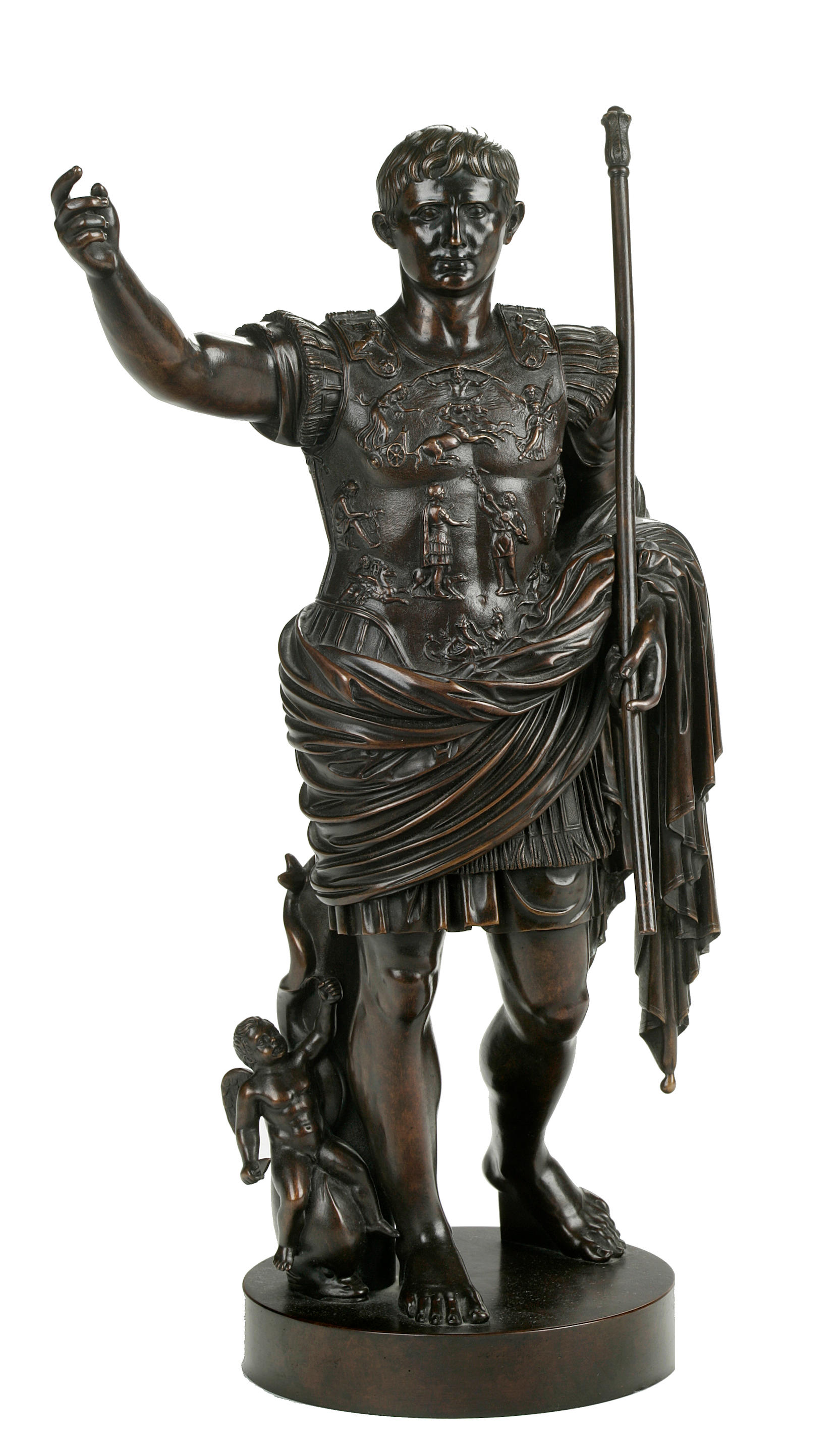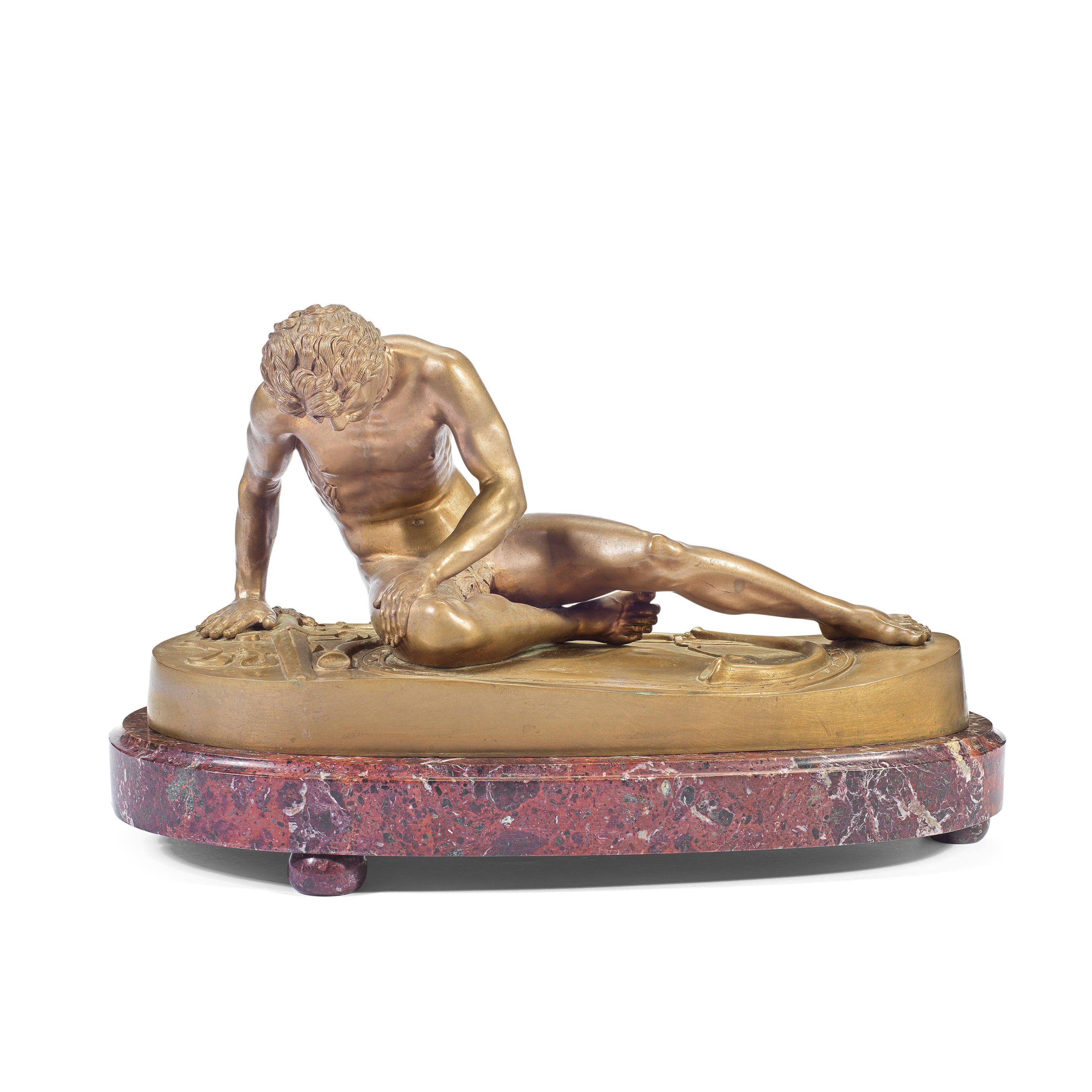Benedetto Boschetti (Italian, fl. 1820-70): A patinated bronze figure of 'The Dying Gaul'After the antique, second quarter of the 19th century The wounded warrior on oval base, signed B. BOSHETTI, ROMA supported on a later antico rosso oval plinth raised on bun feet, 40.5cm long overall, 23.2cm high overallFootnotesIn the early 19th Century Benedetto Boschetti fed the growing demand for high quality works of art with an antique theme created by an influx of grand tourists, many of whom were English. Little is known about his life, but he is known to have worked out of his workshops in the centre of Rome where he produced a large number of classically inspired objects ranging from bronzes to tabletops and mosaics. Active between 1820-1870, the Boschetti workshop exhibited at the Crystal Palace Exhibition in 1851. The workshop was renowned for the exceptional quality of its copies after the 'Antique', mainly in marble and bronze. First recorded in the Ludovisi Collection in 1623, the antique marble known as 'The Dying Gaul' was acquired for the Capitoline Museums by Pope Clement XII, before being ceded to the French in 1797. The sculpture arrived in Paris in a triumphal procession and was housed in the Musée Central des Arts. After Napoleon's defeat at Waterloo in 1815, it was returned to the Capitoline Museums, where its fame was such that it was displayed in a dedicated room named after it. The subject was long interpreted as a Gladiator until late 19th-century scholarship identified the poignant figure as a wounded Galatian, whose army invaded the Hellenistic kingdom of Pergamon in the third century AD. Since the marble's discovery, its popularity has spawned numerous reductions in bronze, marble and alabaster. Related Literature F. Haskell and N. Penny, Taste and the Antique. The Lure of Classical Sculpture 1500-1900, New Haven and London, p. 224-227, no. 44
Benedetto Boschetti (Italian, fl. 1820-70): A patinated bronze figure of 'The Dying Gaul'After the antique, second quarter of the 19th century The wounded warrior on oval base, signed B. BOSHETTI, ROMA supported on a later antico rosso oval plinth raised on bun feet, 40.5cm long overall, 23.2cm high overallFootnotesIn the early 19th Century Benedetto Boschetti fed the growing demand for high quality works of art with an antique theme created by an influx of grand tourists, many of whom were English. Little is known about his life, but he is known to have worked out of his workshops in the centre of Rome where he produced a large number of classically inspired objects ranging from bronzes to tabletops and mosaics. Active between 1820-1870, the Boschetti workshop exhibited at the Crystal Palace Exhibition in 1851. The workshop was renowned for the exceptional quality of its copies after the 'Antique', mainly in marble and bronze. First recorded in the Ludovisi Collection in 1623, the antique marble known as 'The Dying Gaul' was acquired for the Capitoline Museums by Pope Clement XII, before being ceded to the French in 1797. The sculpture arrived in Paris in a triumphal procession and was housed in the Musée Central des Arts. After Napoleon's defeat at Waterloo in 1815, it was returned to the Capitoline Museums, where its fame was such that it was displayed in a dedicated room named after it. The subject was long interpreted as a Gladiator until late 19th-century scholarship identified the poignant figure as a wounded Galatian, whose army invaded the Hellenistic kingdom of Pergamon in the third century AD. Since the marble's discovery, its popularity has spawned numerous reductions in bronze, marble and alabaster. Related Literature F. Haskell and N. Penny, Taste and the Antique. The Lure of Classical Sculpture 1500-1900, New Haven and London, p. 224-227, no. 44
.jpg)





Try LotSearch and its premium features for 7 days - without any costs!
Be notified automatically about new items in upcoming auctions.
Create an alert